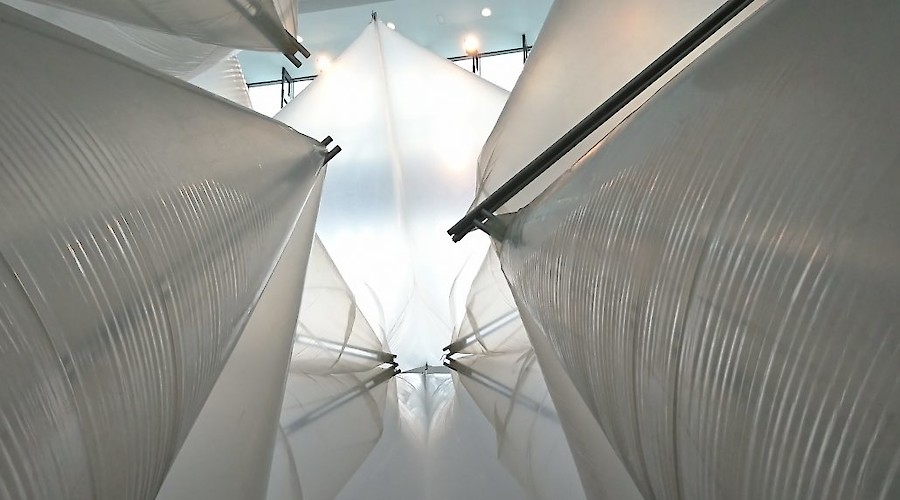Poured Architecture: Sergio Prego on Miguel Fisac

This exhibition establishes a dialogue between the late Spanish architect Miguel Fisac and the contemporary work of the Basque-born, Brooklyn-based artist Sergio Prego.
Due to the current situation caused by COVID-19, the Graham Foundation galleries are temporarily closed.
Sergio Prego is part of a generation of artists from the sculptural tradition from the late nineties that recognizes the importance of performativity when it comes to creating meaning and context in a work of art. In this exhibition, Prego presents a new series of sculptures and drawings inspired by Miguel Fisac’s innovative architecture and construction techniques.
Here, he experiments with the possibilities and synchronicities of materials and processes across architecture and visual art, and the relationship between the body and its location in space by playing with scale and texture. He creates his pneumatic and concrete structures within the context of Fisac’s methodology—chiefly arquitectura vertida, the patented cast concrete system that Fisac created, known in English as poured architecture.
Drawings by Prego, displayed alongside facsimiles of material culled from Fisac’s archive, further illustrate the confluence of the two practices that both employ themes of material fluidity and malleability and investigate using materials such as plastic, concrete, and aluminum.
This exhibition, curated by by Carlos Copertone, Patxi Eguíluz and Iker Gil, invites a multifaceted conversation about architectural imagination, experimentation, and material expression.
About the artists
Sergio Prego (b.1969) is a Basque sculptor and part of the generation that was formed in the experimental space Arteleku in San Sebastián, though for over two decades he has been based in New York City. During the five years he spent in Vito Acconci’s studio, Prego was the only artist in a group of engineers and architects who contributed to the work of the classic conceptual artist. Throughout his career he has questioned and reformulated his allegiance to that tradition, and the performativity and institutional criticism of the art of the 1960s, by means of video, space intervention, sculpture and pneumatic architecture. Along with ItziarOkariz, Sergio Prego represented Spain at the 2019 Venice Biennale.
Miguel Fisac (1913–2006) was a key figure in Spanish architecture of the second half of the twentieth century and his works contributed to the modernization of architecture in Spain. He graduated from the School of Architecture of Madrid in 1942, and his first work was completed that same year: the Church of the Holy Spirit, built upon the remains of the auditorium of the historic Student Residence in Madrid. During a trip to Sweden, he encountered the work of Gunnar Asplund, which influenced Fisac’s architectural perspective. Always working with new materials, his style evolved over time: from abstract classicism he transitioned to using brick, which in turn he later abandoned for concrete —especially pre-stressed concrete, the method Fisac patented. Some of his most emblematic works are from this latter period, such as the Hydrographical Study Centre and the Jorba Laboratories. He was awarded the Gold Medal for Spanish Architecture (1994), the Antonio Camuñas Award (1997), and the National Architecture Award (2002).
About the curators
Patxi Eguíluz is an architect, curator, researcher, and critic focused on construction and urbanism. He is an editor of books on art and architecture at Caniche Editorial and has curated several exhibitions and developed projects at various institutions across Spain. His writing has been published in MAS Context, Openhouse, and Architectural Digest (AD España).
Carlos Copertone received his PhD from the University of Extremadura, specializing in urbanism and regional planning. He is an editor of books on art and architecture at Caniche Editorial and has curated and developed several exhibitions, programs, and projects with Spanish cultural organizations. Copertone has lectured extensively in Spain and abroad and has been published in MAS Context, Openhouse, and Architectural Digest (AD España).
Iker Gil is an architect and director of MAS Studio, an architecture and urban design firm based in Chicago. He is also the editor-in-chief of the journal MAS Context and editor of the book Shanghai Transforming (ACTAR, 2008). He has curated exhibitions for the Chicago Architecture Biennial and the U.S. Pavilion, Venice Architecture Biennale. Additionally, he is the executive director of the SOM Foundation and teaches at the School of the Art Institute of Chicago.
Opening reception on February 11 at 5.30 pm, with comments by artist Sergio Prego and curators Patxi Eguíluz, Carlos Copertone, and Iker Gil. RSVP.